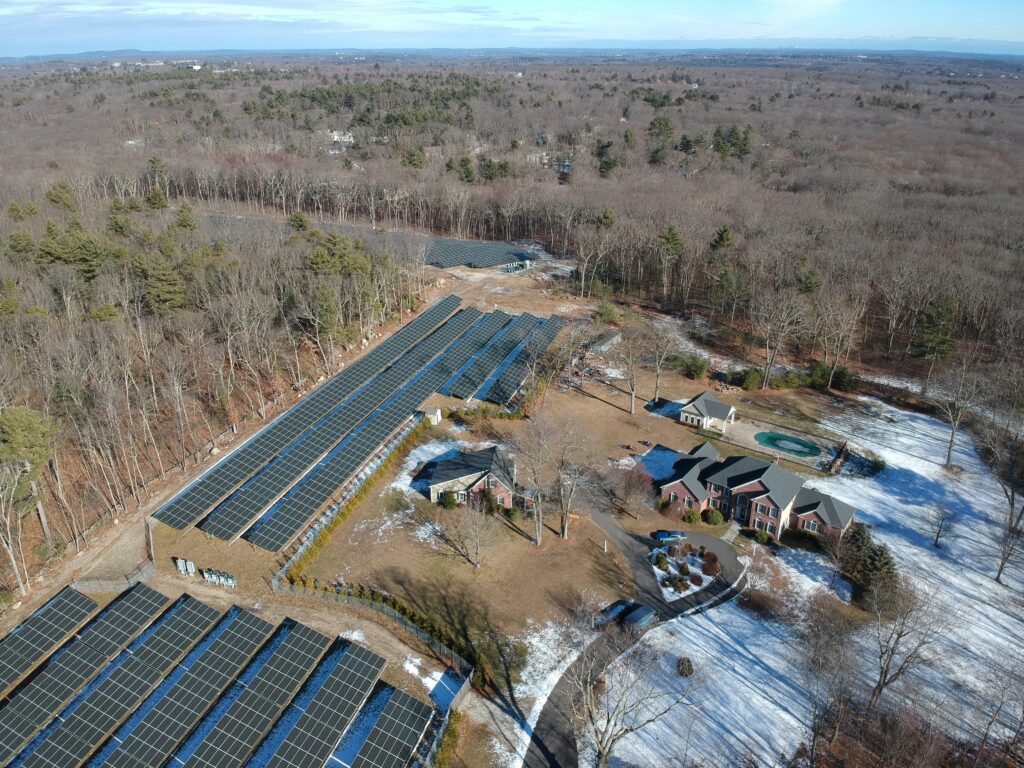During its meeting Monday night, the Zoning Advisory Committee continued its discussion about solar developments, trying to determine whether the best approach to limit commercial ground-mounted arrays is through an overlay district, changes to the bylaw, or a combination of the two.
Following a continuation of their discussion from the previous meeting about specific revisions that could be made to the bylaw regarding screening, setback and the like, committee members weighed in with their overall thoughts about the best approach and expressed a variety of opinions.
Ted Barker-Hook expressed concern about how complicated the suggested bylaw changes are and how that would make it more challenging to convince residents to support it at Town Meeting.
“I fear that all of the stuff we’ve been working on, number one, would be difficult to pass at Town Meeting, and number two, would have very, very, very little teeth, because so much of it is worded in a way that makes it all squishy,” he said. “So ultimately I think, while I’m on board with exploring everything we’ve done and presenting the Planning Board with as many options as possible, I think to achieve what we initially set out to do a year ago — what I heard at our most recent Town Meeting in the fall — I think we need to keep working on a zoning overlay and maybe find our wording in a way that makes it more sustainable than some fear it might be. I think the real answer is through the overlay more than all of these other changes.”
Ria McNamara favored a more direct approach — limiting the size of lots that would be approved for solar, making them less profitable and thus less appealing to developers.
“All these other details are well-meaning, but we don’t even need to go there if we just have something simple,” she said. “It’s simple, we just make it a [maximum] 2-acre parcel that can be used for a solar farm and bam, it doesn’t happen anymore.
“We don’t really need to have this use anymore. We’ve got enough of it here. I just feel very, very strongly about not needing another solar farm in the town of Hopkinton.”
Added McNamara: “I guarantee you, if we just change one word in our current solar bylaw, from ‘on a lot containing a minimum of 3 acres,’ to ‘a lot containing a maximum of 3 acres,’ this whole thing just goes away.”
Principal planner John Gelcich questioned whether that approach would hold up to a legal challenge.
“I think that while on the surface it seems like it’s the solution to the problem, I still haven’t heard the justification as to how a 3-acre lot preserves the health, welfare and well-being of residents enough to stand up in court,” he said, adding that similar solar zoning restrictions in Wellesley and Weston have yet to be challenged, so they shouldn’t be used as an example of a successful strategy.
McNamara pushed back regarding concerns about the town being sued.
“Being afraid of being challenged is not a reason to stop doing zoning,” she said. “That’s just ridiculous. Though I do understand the reason why it’s the health, safety and welfare of the community is because those are subjective points. You can make those be whatever you want them to be, basically. And all we have to do is get someone who’s a really good writer to figure out why we don’t need another solar farm. And that’s the bottom line. The other towns have done it. All we have to do is change one word in our current bylaw and we’re good.”
Ron Foisy said the solar map has him concerned, especially after town counsel expressed some concern about the map ZAC and the Planning Board worked on earlier this year.
“My biggest concern in this whole thing is going back to the prohibition from the state about restricting solar development,” he said, adding: “I’m basically opposed to an overlay district just from the standpoint of I think that we would open ourselves up to a major lawsuit that’s going to be extremely expensive to the town.”
John Coutinho said the town should be proud that land is being used for green energy, and if it takes time to get Town Meeting to approve any bylaw changes, so be it — even if it means it doesn’t get done for another year.
“These hard, difficult changes should be difficult to pass at Town Meeting. … The really tough ones take a lot to get through,” he said. “They take a lot out of us, they take a lot out of the Planning Board, and they take a lot out of Town Meeting. And I get it. … I get that we want to get stuff through Town Meeting and clean and get the changes done nice and easy and as efficiently as possible.”
Added Coutinho: “We should look at this, but be careful of how many changes we do. And we should really listen to the people. It’s not going to be something that’s going to sail through [Town Meeting]. … Let’s continue to work on this. It’s an important one.”
Curtis Smithson said he preferred bylaw changes, perhaps adding one that restricts clearing certain kinds of trees.
“I’m not real sure the overlay district is the right way to go,” he said. “I think beefing up the bylaw with requirements on clearing, which seems to be a major issue, making sure we don’t have eyesores, taking into effect what the view is going to be. And maybe going a little further, which may be something that doesn’t go over well, we keep saying that we can’t tell people not to cut these [trees], and I go back to [a previous experience in] Libertyville, Illinois, they had a specimen tree, when you get to a certain size, that tree is regulated.
“It is an integral part of what Hopkinton’s about. Maybe in addition to what we’re talking about here, maybe some forestry management or specimen tree-type things need to be looked at so they do have a little bit more teeth on preserving some of the older growth areas. … Having something to regulate the view and maybe cut down the clearing, some bylaw modifications would be the best way to get into it and kind of restrict the parts we don’t like about the solar farms, without saying no solar farms.”
Chair Mary Larson-Marlowe asked committee members to come to the next meeting with some specific ideas and prepared to defend them.
“I am very torn myself in terms of how we can make some of this work,” she said. “I don’t think we can put everything we talked about into a bylaw change, and I don’t think we would want to, necessarily. But I don’t believe necessarily that an overlay district is probably the best way to go forward because of the justification of it, trying to specifically justify the selection of lots based on public health, safety and welfare. I don’t see how that can be done, but I challenge some people who were championing the overlay district to work on it from that aspect before our next meeting. Look at it in terms of how we can justify it, the criteria that we would judge sites or lots by.
“And those of you who are leaning more toward ‘Let’s pick one or two impactful changes to the wording of the bylaw,’ again, we need to justify it by the public health, safety of welfare. And that is what each of us should be thinking about in terms of how we’re going to justify these changes from a legal perspective as best we can.”
The discussion was continued to the committee’s next meeting on Dec. 28. The committee is looking to get something in the hands of the Planning Board soon, as the 2021 Town Meeting warrant opens Jan. 4 and closes in early February.
















0 Comments